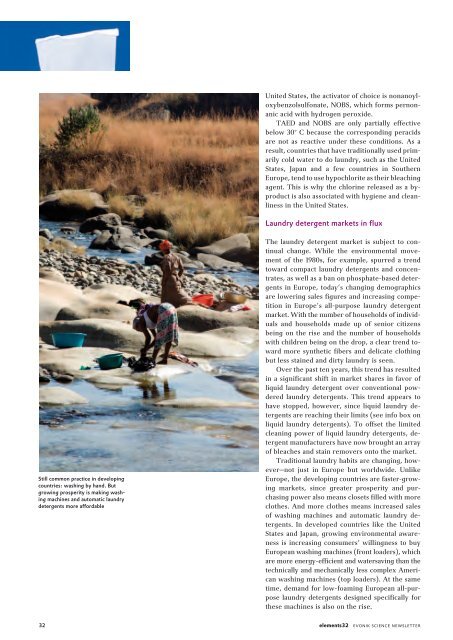Download - Evonik Industries
Download - Evonik Industries
Download - Evonik Industries
Create successful ePaper yourself
Turn your PDF publications into a flip-book with our unique Google optimized e-Paper software.
Still common practice in developing<br />
countries: washing by hand. But<br />
growing prosperity is making washing<br />
machines and automatic laundry<br />
detergents more affordable<br />
United States, the activator of choice is nonanoyloxybenzolsulfonate,<br />
NOBS, which forms pernonanic<br />
acid with hydrogen peroxide.<br />
TAED and NOBS are only partially effective<br />
below 30° C because the corresponding peracids<br />
are not as reactive under these conditions. As a<br />
result, countries that have traditionally used primarily<br />
cold water to do laundry, such as the United<br />
States, Japan and a few countries in Southern<br />
Europe, tend to use hypochlorite as their bleaching<br />
agent. This is why the chlorine released as a byproduct<br />
is also associated with hygiene and cleanliness<br />
in the United States.<br />
Laundry detergent markets in flux<br />
The laundry detergent market is subject to continual<br />
change. While the environmental movement<br />
of the 1980s, for example, spurred a trend<br />
toward compact laundry detergents and concentrates,<br />
as well as a ban on phosphate-based detergents<br />
in Europe, today’s changing demographics<br />
are lowering sales figures and increasing competition<br />
in Europe’s all-purpose laundry detergent<br />
market. With the number of households of individuals<br />
and households made up of senior citizens<br />
being on the rise and the number of households<br />
with children being on the drop, a clear trend toward<br />
more synthetic fibers and delicate clothing<br />
but less stained and dirty laundry is seen.<br />
Over the past ten years, this trend has resulted<br />
in a significant shift in market shares in favor of<br />
liquid laundry detergent over conventional powdered<br />
laundry detergents. This trend appears to<br />
have stopped, however, since liquid laundry detergents<br />
are reaching their limits (see info box on<br />
liquid laundry detergents). To offset the limited<br />
cleaning power of liquid laundry detergents, detergent<br />
manufacturers have now brought an array<br />
of bleaches and stain removers onto the market.<br />
Traditional laundry habits are changing, however—not<br />
just in Europe but worldwide. Unlike<br />
Europe, the developing countries are faster-growing<br />
markets, since greater prosperity and purchasing<br />
power also means closets filled with more<br />
clothes. And more clothes means increased sales<br />
of washing machines and automatic laundry detergents.<br />
In developed countries like the United<br />
States and Japan, growing environmental awareness<br />
is increasing consumers’ willingness to buy<br />
European washing machines (front loaders), which<br />
are more energy-efficient and watersav ing than the<br />
technically and mechanically less complex Amer i -<br />
can washing machines (top load ers). At the same<br />
time, demand for low-foaming European all-purpose<br />
laundry detergents designed specifically for<br />
these machines is also on the rise.<br />
32 elements32 evonik science newsletter

















